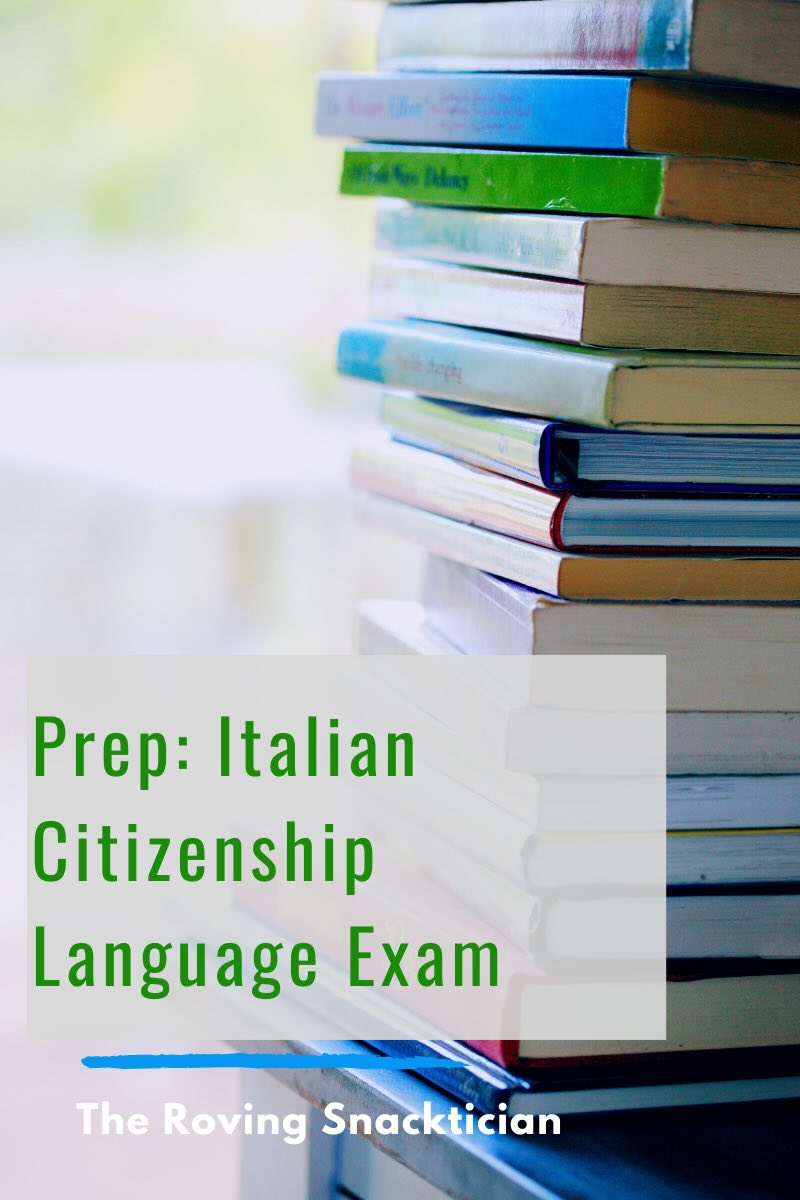This is a second in a series on taking the CILS Italian Citizenship B1 Exam. If you haven’t yet read the first part on preparing for the exam, you can find it here.
The CILS test is run by the University of Siena and proctored all over the world. While some small differences may exist where you take your test, this is what we experienced in Florence—and was echoed by friends who took it in the United States. The test itself is 100% standardized—mailed by University of Siena to the proctor locations the day before the test. Many levels (B1, B2, C1…) take the test in the same few days, so it is quite a production.

Sections/ Scoring Overview
There are 4 sections to the test: Listening, Reading Comprehension & Grammar, Writing, and Speaking.
Each section has a potential of 12 maximum points. While you need a total of 28/48 to pass the overall test—you cannot get below a 7 on any one section and still pass. So better to be “kind of good” on all of them, than great on one and awful in another.
Registration
About a month before the test is when registration closes. We went to the testing location with our id’s and payment (we used US passports and a credit card) to get signed up for the test. (Our friend who took the test in the US was able to sign up and pay online.) If you check on the CILS website, they will tell when the cutoff is for registration for each exam.
Arriving
The B1 Citizenship exam is “only” a little over 2 hours. In Florence this means we arrived in the afternoon. There were about 25 or 30 people taking the exam. We were split between two rooms—for space reasons. We were seated in a room with two large tables (about 6 people per table; they seated Mr Snacks and I at separate tables), the other room appeared to have individual writing desks.
When we arrived, we were told to take out our BLACK pen (Italy is very specific that it must be black) and wait for instructions. When everyone was seated, they talked to us about our test stickers (handed to us as we checked in), which had our matriculation numbers on them. You affix the stickers to each part of the test you turn in. You also keep a copy of the matriculation number, as you will need it later to look for your test results. They gave a quick walk through of the test format and the website and timing to expect results.

Listening
30 minutes
There are two segments to this section. First, you will listen to 6 short dialogues (a woman calling about swim lessons for her kids, a train announcement, a radio announcement for a sale on fish…) all played back-to-back. This total audio is probably 2-3 minutes long in total. There is multiple choice question with 3 choices for each dialogue. You have a moment to quickly read through the multiple choice (maybe 3 minutes?) and then they play the whole dialogue again. You get a long time (10ish minutes) to determine your answers and mark the bubbles on the form.
The second segment is two different audio clips, and you will choose which 3 of the 6 provided multiple choices is applicable for each clip. Like before, they will play it twice with a few minutes of pause in between, and then there will be about 10 minutes to finalize your answers and fill out the response form.
Based on reading other students’ comments, I was very concerned about the quality of the audio. For us, our school used a small, high-quality Bluetooth speaker (JBL, I believe) and the quality of the audio clip was good and at a good volume. Any challenges I had were solely because of the Italian, and nothing to do with my ability to hear it well.
Tips: Try to read the responses before they play the audio, if you have time. This will give you at least an idea of what they will talk about. Take notes as they play the audio, rather than searching for the correct answer. Pay attention to the details of the audio—they specifically will reuse exact words from the audio, but in the wrong context to trick you. (Example, they give an answer of “Luca called the plumber” when the audio clip might have said “I didn’t need to call the plumber, but I did call the mechanic”. Your brain will get excited because you hear plumber and see plumber…but it’s important to try hard to understand the full extent of what’s being said.)
Reading Comprehension & Grammar
40 minutes
There are two parts to this section. The first is reading a text about one full page long and determining which 6 of the 12 multiple choice options apply to the text. Ours was a job interview posting. The responses didn’t mirror the exact language from the text, so you needed to have a strong enough understanding to make the correlation. (The region of Emilia Romagna and the Comune of Modena have a job posting in the city’s library. This means the option of “posts are available in all libraries in the region” is not correct.)
The second was a half-page of text, with 6 blanks and you had to select the correct word from the 3 options they gave you. This tested reading comprehension, vocabulary and grammar (choosing from tenses of avere, choosing between per/su/con…).
When we were finished with this section, we were told to drop off our scan response forms, as they are not used in the upcoming sections of the exam.
Break
We got a 10 minute break after the Reading Comprehension, prior to the Writing section.

Letter
40 minutes
Two texts are provided, and you read them both and then choose which one you prefer to write for. I chose to write about a suitcase that was sent to me that was not as I had ordered.
Write your draft on the back of your test booklet, as they say you don’t want to write and scribble out a lot on your response page. A woman in my exam asked if she could get a new response page because she had screwed up, and the proctor said they did not have extras they could give her.
From practices, you’ll be very accustomed to working to hit the specific word count for the response. If your draft is short 10 words or so, you’ll need to create an extra sentence to put in, and you can easily do that in a draft—but not if you’ve started on your response sheet with a black pen.
Whenever you were completed, you could hand your response sheet in and go hang out in the common area or sit at your desk.
Speaking
In our testing center, there were about 3 or 4 testers conducting the speaking portion. This means that your wait for this portion might be quick or long. Mr Snacks went almost immediately, and I was one of the last ones. As an instructor was completed with one speaking section, they called out a student’s name and went with that person to a private classroom.
Once you are seated with your tester, they hand you a piece of paper that says the conversation will start with a brief personal introduction and continue with one of 4 conversation topics. They outline what each of those 4 options are, and you choose the one you are most comfortable with. Our choices included shopping, household chores and sports in your country. My tester left the room and gave me a few minutes to read the topics. I chose sports.
When she returned to the room, she started a recording, stated my name and matriculation number and began the conversation. She didn’t follow the script precisely and asked why I was taking the test, which completely threw me—I should have had the answer ready, but I didn’t and it flustered me. We then moved into talking about sports in the US—what was popular to watch on TV and what sports I played. I did pass this portion, but I didn’t leave feeling like I had crushed it as I did on the other sections.
At this point, you just leave when you are finished. There’s no big celebration, or hoopla to say you’ve finally completed this scary test—just a long period of waiting to find out your results.

One Reply to “Test: Italian Citizenship Language Exam”
Comments are closed.